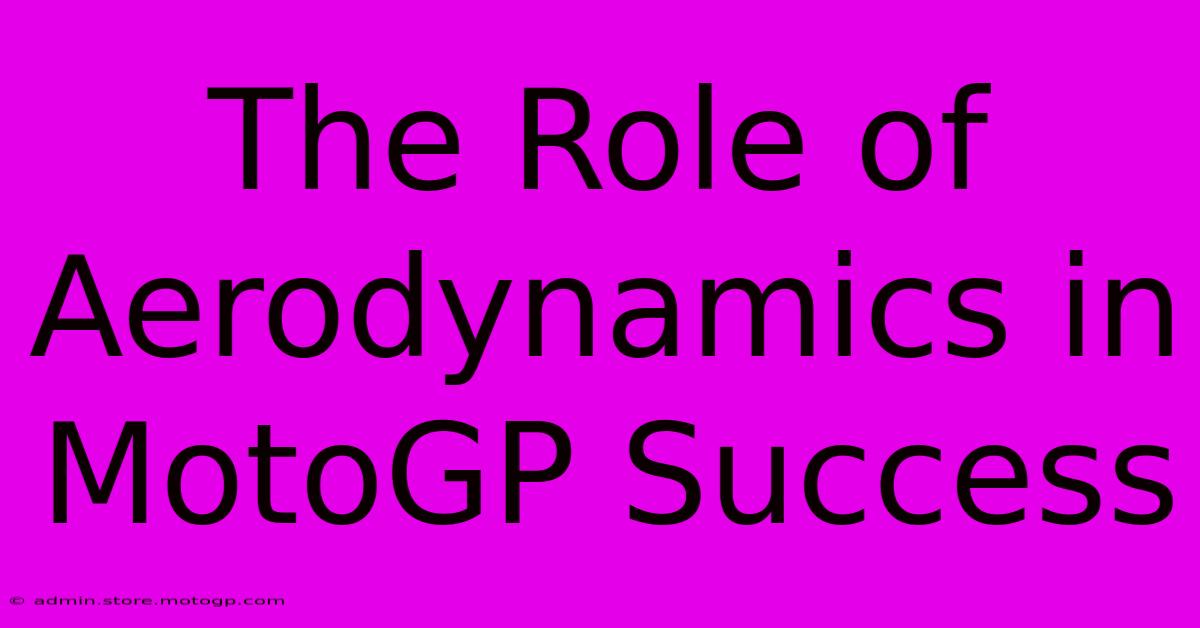The Role Of Aerodynamics In MotoGP Success

Table of Contents
The Role of Aerodynamics in MotoGP Success
MotoGP, the pinnacle of motorcycle road racing, is a relentless battle for milliseconds. Every advantage, no matter how small, can be the difference between victory and defeat. While rider skill and engine power are crucial, the increasingly significant role of aerodynamics in achieving MotoGP success cannot be overstated. This article delves into how aerodynamic advancements contribute to faster lap times and ultimately, championship wins.
The Science of Speed: Understanding Aerodynamic Principles in MotoGP
Aerodynamics, the study of air in motion, plays a vital role in MotoGP. The goal is to manipulate airflow to create downforce (force pushing the bike towards the track) and reduce drag (resistance to movement). These seemingly simple concepts translate into substantial performance gains.
Downforce: The Grip Factor
Downforce is arguably the most important aerodynamic element. It increases the contact pressure between the tires and the track, providing superior grip, especially during cornering and braking. This improved grip allows riders to:
- Lean further into corners: Increased grip permits higher cornering speeds, a key factor in shaving off crucial seconds per lap.
- Brake later and harder: The enhanced traction translates into more effective braking, allowing riders to carry more speed into corners.
- Maintain stability at high speeds: Downforce helps maintain stability at high speeds, reducing the risk of high-side or low-side crashes.
Drag Reduction: The Speed Enhancer
While downforce is crucial for cornering, drag reduction is essential for maximizing straight-line speed. Reducing drag minimizes air resistance, allowing the motorcycle to accelerate faster and reach higher top speeds on the straights. This translates to:
- Faster acceleration: Less air resistance means quicker acceleration out of corners, giving riders a crucial advantage on the straights.
- Higher top speeds: Reducing drag directly increases the motorcycle's maximum speed, a significant factor on long straights.
- Improved fuel efficiency: Lower drag can even contribute to slightly better fuel economy, a factor in endurance races.
Aerodynamic Innovations in Modern MotoGP Bikes
Modern MotoGP bikes are marvels of engineering, constantly pushing the boundaries of aerodynamic performance. Key innovations include:
Winglets and Fairings: Shaping the Airflow
Winglets, small aerodynamic surfaces, generate significant downforce without significantly increasing drag. They are strategically positioned on the fairings (bodywork) to manipulate airflow and direct it downwards. The design and placement of winglets are constantly evolving, with teams experimenting with different configurations to optimize performance.
Fairings themselves are meticulously designed to minimize drag and maximize downforce. Computational fluid dynamics (CFD) simulations play a crucial role in optimizing the shape and design of these components. Small adjustments to the fairing can result in noticeable performance improvements.
Underbody Aerodynamics: Harnessing the Ground Effect
Ground effect, the phenomenon where air pressure is reduced beneath a surface, is being increasingly exploited in MotoGP. Sophisticated underbody designs help create a low-pressure zone beneath the bike, further increasing downforce. This technology requires precision engineering and careful management of airflow to avoid negative effects such as instability.
The Future of Aerodynamics in MotoGP
The pursuit of aerodynamic advantage is an ongoing arms race in MotoGP. We can expect even more sophisticated technologies in the coming years. This includes:
- Advanced CFD simulations: More powerful computing capabilities will allow for even more precise simulations, leading to finely-tuned aerodynamic designs.
- Active aerodynamics: Systems that adjust aerodynamic components in real-time based on speed and track conditions will likely become more prevalent.
- Biometric integration: Data from rider movements and forces could be used to optimize aerodynamic performance even further.
In conclusion, aerodynamics is no longer a secondary consideration in MotoGP; it’s a fundamental pillar of success. The relentless pursuit of aerodynamic efficiency, driven by advanced technology and meticulous engineering, will continue to shape the future of this thrilling sport. The battle for aerodynamic supremacy is as intense as the battle on the track itself.

Thank you for visiting our website wich cover about The Role Of Aerodynamics In MotoGP Success. We hope the information provided has been useful to you. Feel free to contact us if you have any questions or need further assistance. See you next time and dont miss to bookmark.
Featured Posts
-
Experience The Power Moto Gp Bike For Sale
Feb 19, 2025
-
Moto Gp Crash The Importance Of Mental Strength
Feb 19, 2025
-
Formula 1 Parking Enjoy The Race In Style
Feb 19, 2025
-
Us Gp Sprint Get The Inside Scoop
Feb 19, 2025
-
Top 5 Moto Gp Helmets For Maximum Safety
Feb 19, 2025
